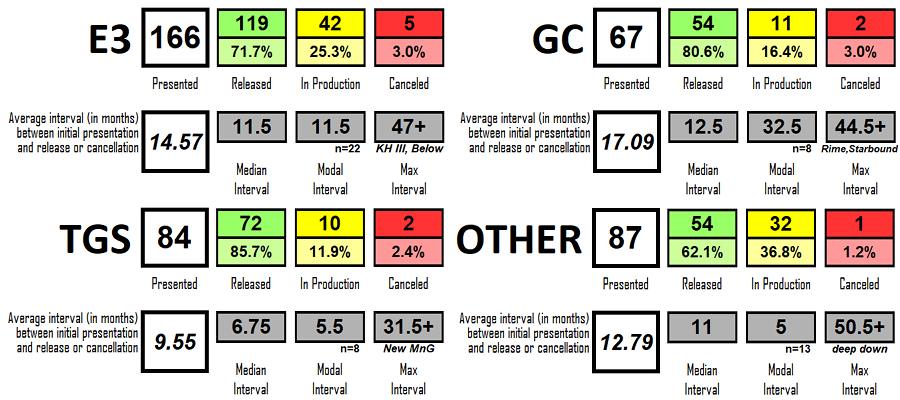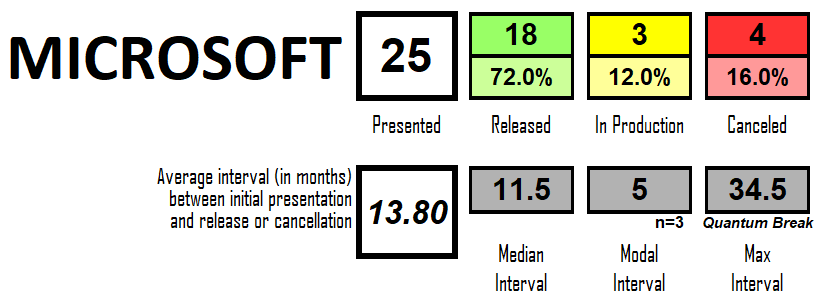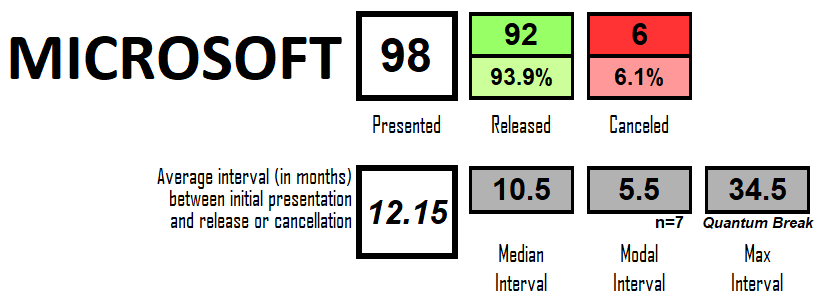I'd be interested to see how open world games fare against more linear ones.
Sorry, but I likely won't get around to splitting the games into types. To do it accurately would probably take as much research as all the rest of what I've done put together.
But let's recap what we have looked at. To start, here was the way I characterized the general expectations I think people had:
- Some games seem to be revealed too early, as evidenced by CG trailers when gameplay isn't ready
- Games get shown for multiple years before they actually come out
- The AAA blockbusters are especially prone to lengthy dev time
- Sony is worse about announcing early than Microsoft or Nintendo
How does the data stand against this shared set of beliefs?
Some games seem to be revealed too early, as evidenced by CG trailers when gameplay isn't ready
Only 10% of games for the whole generation (21 Microsoft, 20 Sony) have been shown as CG trailers, so this isn't rampant. And generally, games released after CG showings don't take a lot longer to come out than titles shown with gameplay first. However, there are issues on both sides. For Sony, in some instances CG does seem to have covered for overly early announcements.
Deep Down, Rime, Dead Island 2, and
Shadow of the Beast do seem to have been unready for public showing (especially since a couple of these games aren't guaranteed to come out at all). For Microsoft, development is pretty uniformly normal in length...but 4 such games have been canceled before release. That's a whopping 19% of their CG-shown titles canceled, as opposed to less than 2% of other titles.
Games get shown for multiple years before they actually come out
This isn't true in general. As my results show, both platforms average under 15 months to release, and over half the games on each come out before a year is up. (Though it must be acknowledged that these are slight underestimations, for reasons explained in the OP.) Disregarding indies--in the sense of games with relatively lower production values--drops these results even lower, as does looking just at first-party efforts, or looking just at games that've already released. The impression of overall lengthier times must stem from concentration on specific titles. Of all games shown, 109 (27.0%) aged less than six months; 112 more ( 27.7%) less than twelve months; 124 more (30.7%) less than two years; 51 (12.6%) less than three years; and only 8 (2.0%) took or are taking longer. That's over 85% of games younger than two years.
The AAA blockbusters are especially prone to lengthy dev time
This point is pretty straightforwardly untrue. Only 22 AAA games have aged more than two years. That's 11% of all AAA, as opposed to 19.1% of non-AAA. As mentioned upthread with more numbers, indies are significantly more likely to have extended development cycles.
Sony is worse about announcing early than Microsoft or Nintendo
I regrettably have no comparisons for Nintendo (though as explained in the OP their business has been different enough that I'm not sure direct juxtaposition would even make sense). But as explicated more fully in the rest of the thread, this conclusion doesn't hold versus Microsoft. Looking at all games, Microsoft's mean/median/modal intervals are longer. Looking at just AAA games, they're longer. Looking at just first-party AAA games, they're longer. Looking at just games announced through E3 2015, they're longer. Looking at just games that have been released, they're longer. Sony shows a lot of remasters/remakes, and those "easy" titles could be distorting the results...but removing them still leaves Microsoft with longer intervals. Some of Sony's games started development years earlier on different platforms, so maybe we should include those stretches...but even if we do (and even if we don't do the same for Microsoft), then Microsoft's numbers are still higher.
In short, many different counting schemes and adjustments have been proposed, but none of them is sufficient to reverse the situation seen in the wide count of all titles. Because the gap isn't enormous, there exist some multiplex combinations of sampling which will flip the order. (Though I doubt any reasonable protocol could get it heavily reversed.) But this fact runs up against a critical lesson that was brought home to me by SalesGAF discussions. If you're saying, "If you ignore [x], [y], and [z], then Sony would take longer to release games", that's
exactly the same statement as "Sony do not take longer to release games, and [x], [y], and [z] are the reasons why."
Of course, all the discussion above is about properties of sets. There's still the possibility that variability differs between the platforms, which could lead to interval quartiles with divergent traits. For example, of the 22 AAA games which have aged more than two years, how many were first shown by Sony? The answer is 16, versus 6 from Microsoft, which seems to support the conjecture. But, Sony shows more games in total, at a ratio of about 2.6:1. So that spread is actually just what you should expect.
And this pushes us toward an explanation of why public perception may be skewed as it is. There are simply more long-delayed games on the Sony side, so it's easier to recall examples. Meanwhile, the fact that there's also more
undelayed games doesn't register as a factor. (For instance, Sony is the only platform of the two that has released games less than a month after their first showing.) I believe this alone is sufficient to explain much of the usual narrative. That delayed Sony games spring easily to mind is quite compelling, and the associated reasoning is plausible. That's why until I ran the actual numbers I expected to find all this stuff to be easily true. It's exciting that the results were surprising!





